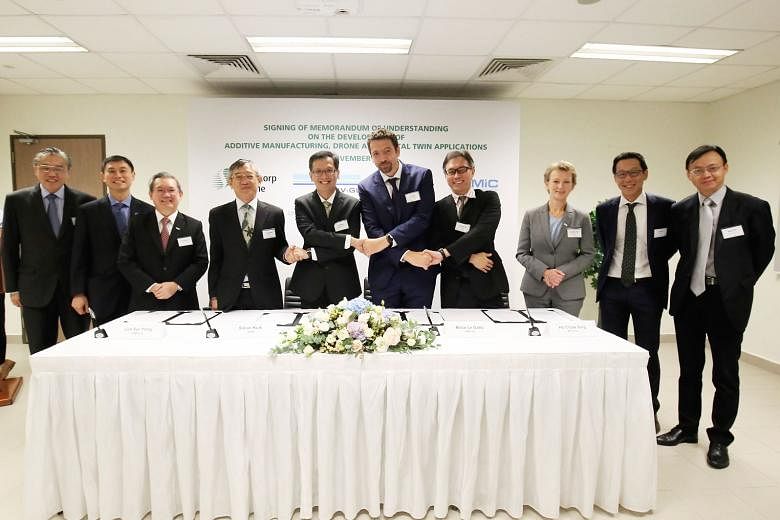Sembcorp Marine has embarked on an industry-government collaboration to develop disruptive applications in drone, additive manufacturing (3D printing) and digital twin technologies that can revolutionise the offshore and marine (O&M) sector and boost its global competitiveness.
The company signed yesterday a memorandum of understanding (MOU) with DNV GL, A*Star's Singapore Institute of Manufacturing Technology (SIMTech) and the National Additive Manufacturing Innovation Cluster (Namic).
DNV GL is a quality assurance and risk management company for the oil and gas, power and maritime industries.
The partners will apply laser-aided additive manufacturing (AM) to fabricate large-scale structures for newbuild offshore and marine constructions in a project that will begin by the year's end.
This technology gives great flexibility to translate designs into actual products and has the potential to save on material costs and reduce production lead-time, said SembMarine president and CEO Wong Weng Sun in a speech at the MOU signing.
For example, traditional manufacturing processes involve subtractive manufacturing, where materials are removed from a large material template to form a shape or an item. In AM, items are built upwards, layer by layer, into the three-dimensional shape, said the company.
The partners will also explore AM technology in printing replacement components for ship repairs.
The venture has received grants from Namic for two AM pilot projects - one for the repair of ship components and the other for fabricating large-scale newbuild structures. These AM parts will be printed locally with SIMTech, while DNV GL will provide testing and subsequent certification.
SembMarine will also be working with DNV GL to develop drone technology for close-up inspection of newbuilds and ships undergoing repairs in a project that begins later this month.
Traditional methods of visual inspections in shipyards involve erecting scaffolding, a labour-intensive task. With the use of drones, ship owners will not have to worry about scaffolding dirtying or damaging their ships during the inspection.
In the future, the versatility of drones can also offer applications in other shipyard operations, such as using sensors for security monitoring, and for unmanned monitoring of hazardous works.
Digital twin is the third disruptive technology SembMarine will be developing with DNV GL. It refers to the digital replica of an actual physical asset. In the O&M sector, digital twin technology can be applied in the pre-commissioning of vessels, doing away with the need to wait for the physical ship to be built before testing the systems for installation. This can bring about significant time and cost savings in the design and commissioning processes, said Mr Wong.
Another use of this technology is in preventive maintenance, where sensors attached to structures detect possible structural failure and feed data into the digital twin model.
"The developmental areas we are investigating all have promising potential to bring about transformational improvement to the O&M industry," said Mr Wong.
The projects will be undertaken at SembMarine's flagship Tuas Boulevard Yard, which will serve as a living lab. The 108ha yard in Singapore has six drydocks catering to new-generation mega-size vessels, and one extra-wide drydock for the construction and repair of offshore structures.
The yard also has a 120,000 sq m covered facility that can fabricate up to 144,000 tonnes of steel components annually.


